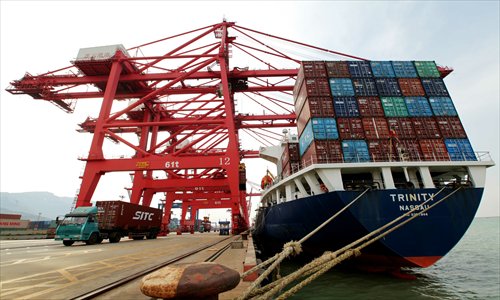Clarification eases phony trade fears
Different methods main reason for data gap: MOFCOM

Goods are unloaded at Lianyungang Port in East China's Jiangsu Province. Photo: CFP
A Chinese government official offered a clarification on Wednesday following recent concerns about a rise in phony trade in China, with December trade data announced by customs in the Chinese mainland and Hong Kong showing a discrepancy of more than $20 billion.
At a press conference on Wednesday, Shen Danyang, spokesperson for the Ministry of Commerce (MOFCOM), attributed the data gap to factors such as use of different statistical methods in the two territories, as well as currency conversion.
The General Administration of Customs (GAC) announced on January 13 that exports from the Chinese mainland to Hong Kong amounted to $46 billion in December 2015.
Data from the Hong Kong local government, however, tallied imports in the territory from the Chinese mainland at $23.7 billion in December, according to the GAC.
Bloomberg said in a report on January 26 that the discrepancy suggests China's December trade had been "inflated by fake invoicing to skirt capital controls and profit from the difference between the yuan's exchange rates in onshore and offshore currency markets."
Shen said MOFCOM had "noticed the discrepancy," but said that China's trade data for December was "generally normal."
Different statistical methods
According to Shen, the volume of Chinese mainland exports to Hong Kong has been higher than Hong Kong's import volume ever since 2006. The gap reached a peak of $25 billion in March 2013.
One of the reasons for the data gap is the different statistical methods used by the two places, said Shen, who pointed out that there are several types of commodities that are excluded from Hong Kong's imports statistics, but that are included in the mainland's exports statistics.
There are three types of such commodities. The first is transshipment cargo exported from the mainland to Hong Kong, which will then be exported to other places.
Dong Dengxin, director of the Finance and Securities Institute at Wuhan University of Science and Technology, told the Global Times on Wednesday that Hong Kong is a center of intermediary trade because of its geographical position.
Therefore, it's necessary that it adopts a local statistical method that distinguishes direct shipping from transshipment.
The other two types of goods are gold products such as jewelry and commodities that are assembled, rather than made, in the Chinese mainland.
"The difference in statistical methods in the Chinese mainland and Hong Kong is normal and does not need to be changed," Dong said.
Shen also noted that two different currencies are used for trade settlement, the yuan and the HK dollar, and when their trade volume is converted into US dollars, it might lead to a certain level of data discrepancy.
Phony trade still an issue
Dong nevertheless noted that phony trade "can't be entirely ruled out."
As the US dollar strengthened against the yuan recently and the offshore and onshore yuan exchange rate gap widened, domestic investors might have wanted to increase their holdings of US-denominated assets.
However, as the Chinese government has strict regulations for overseas investment and financing, they could only do that via trade.
"For example, they could fabricate an export contract, convert the equivalent yuan-denominated 'payment' into US dollars, and transfer the money abroad," Dong noted.
Bai Ming, a research fellow at the Chinese Academy of International Trade and Economic Cooperation under MOFCOM, told the Global Times on Wednesday that as the weeklong Spring Festival holidays approach, domestic companies might have counterfeited exports contracts to "make business look good."
But these would be "random cases" rather than a general trend, Bai noted.